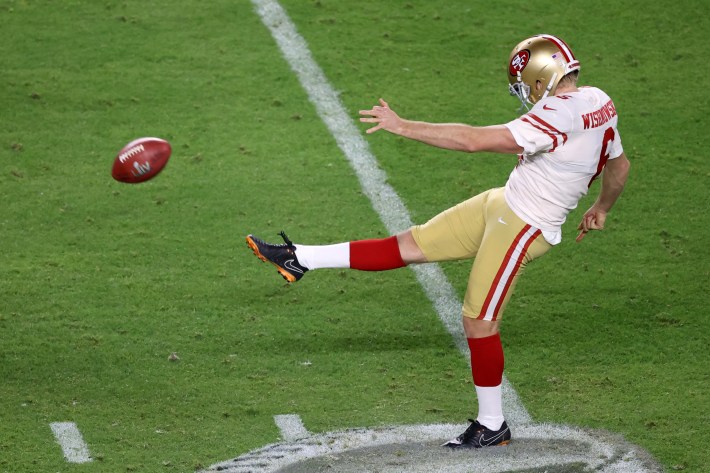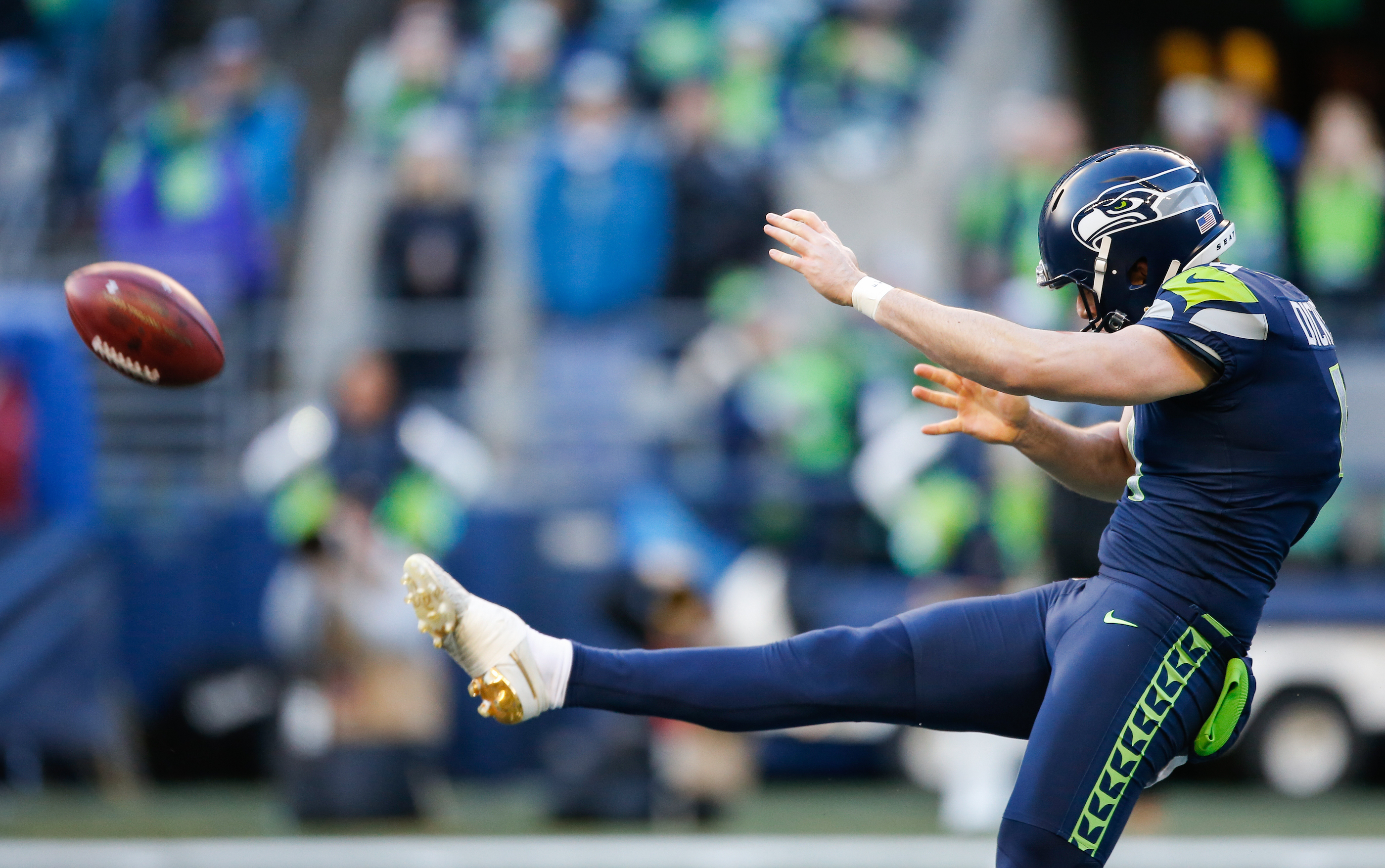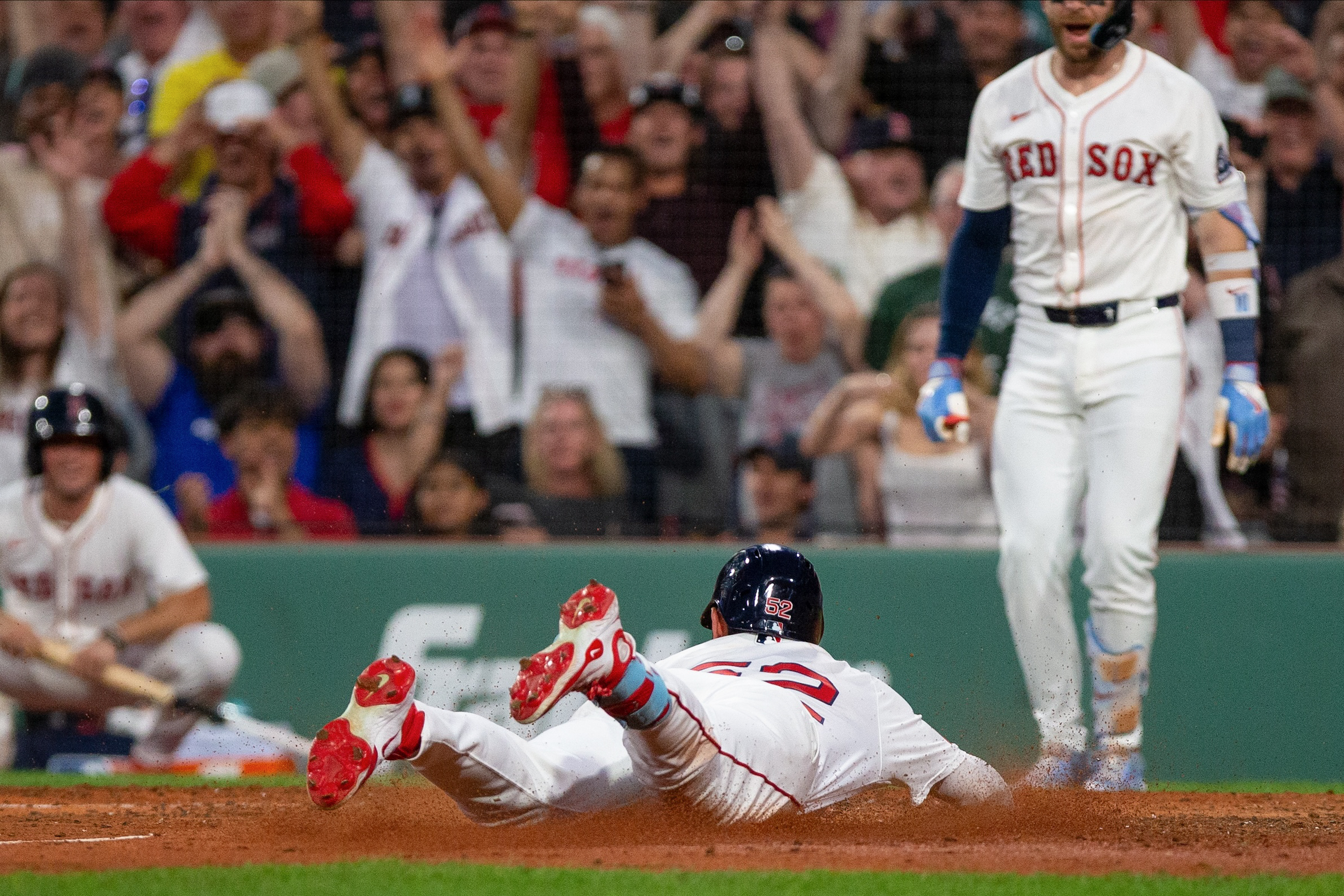The clips started circulating a decade or so ago, viral examples of the least-loved play in football. In the videos, Australian punters sent balls tracing in tight spirals at top-percentile vertices of hangtime and distance to single-digit yard lines, or swerving so mightily that they crossed left-to-right in front of the returner’s facemask, or backspinning with such practiced touch that they met the turf and stuck, like so many tennis balls to Velcro. They launched their kicks under all manner of duress and in all sorts of game circumstances, each time advancing what has become an agreed-upon thesis: Australian punters are the best in the world at what they do.
In a half a generation’s time, Australians have gone from football interlopers to standard-bearers. It is not just their massing ranks (this season, nearly 40 percent of Division 1 punters hail from the country) or statistical success (a pair of Australians lead the NFL in cumulative yardage); it is their reshaping of the sport’s interlude, its universal fridge break, into something worth sticking around for. In early October, after the Los Angeles Rams blocked a try from Seattle’s Michael Dickson, Dickson scrambled after the bouncing ball and plucked it one-handed off the field. Dodging a couple more free rushers, he then ripped an on-the-fly second kick—a side-legger with the tottering trajectory and triumphant outcome of an action-movie helicopter traversing a hurricane—69 yards, pushing the Rams all the way back to their own 11-yard line. The internet’s puntersphere went ballistic; the Twitter account for Puntalytics, a site dedicated to the advanced stats of field-flipping, deemed it the greatest punt in NFL history. (It was rare enough that Mike Pereira, FOX's rules analyst, initially called the play illegal.) Dickson credited his lineage. “It was just like a normal Aussie rules play, something I’ve done since I was 9,” he said afterward. “What’s important at a time like that is to rely on your instincts.”
The NFL Films shot of the highlight of week, #Seahawks Michael Dickson double punt.pic.twitter.com/wloNM9DD4r
— Dov Kleiman (@NFL_DovKleiman) October 12, 2021
As punters across football achieve unprecedented success—50 is the new 40—the “Aussie invasion” has come to represent a standard-setting blend of might and moxie. That narrative smacks of sportswritery simplification, all other-hemisphere origins and square-one disruption—a whole continent of Sidd Finches. It also happens to be true. Brought up in Australian rules football, whose gameplay relies on using controlled kicks to advance the ball to teammates and harder ones to score from distance, punting’s new guard has ushered in an era of longer balls, wickeder spins, and softer landings. They have reframed their position, turning an act of sacrifice—the cutting of losses after a lousy drive—into one of aggression, a penning-in of the oncoming offense. “Australians have a different leg swing—it’s unique to their training, different from what punters get in Canada or the U.S.,” Puntalytics’ Raphael Laden-Guindon said. “The timelines align—since they’ve started coming over, teams have gotten much better at pinning opponents deep.”
The preconditions for this takeover were always there, on schoolyard fields and in the junior ranks of the Australian Football League. But both the actualization of the trend and the individual paths of nearly every participant can be traced to Prokick Australia, the Melbourne-based academy now synonymous with the broader movement. Founded in 2006 by Nathan Chapman and John Smith, a pair of washed-up kickers themselves, as little more than a sketched regimen and a collection of secondhand helmets, Prokick now boasts a rolling enrollment of some 40 trainees. The job is to teach a stalled athlete—a former footy player, usually—a new game, quickly, and then send him on his way. The program has become arguably the world’s most reliable pipeline of high-level football talent outside of Tuscaloosa, with its alums earning six Ray Guy Awards, five NFL spots, and more than 17 All-American honors. That last number hasn’t been updated on Prokick’s official website since 2018; promotion, by now, more or less takes care of itself.
It is generally wise to look askance at private-coaching enterprises, in whichever sport on whichever side of whichever ocean. In the best cases, they can tend toward unnecessary refinement, robbing elite athletes of game-honed instinct. In the worst, they convince people that they can attain levels they won’t. But Prokick’s athletes need the program’s help—nearly every one of them reaches the States without having played a snap of gridiron football—and almost universally realize its baseline goal. Since the inaugural class in 2009, 182 Prokickers have won scholarships to U.S. colleges.
Ask around among alums, and you’ll get different explanations for that success: the Aussie’s knack for boot on leather, Chapman’s eye for leg-swing and ear for contact, Smith’s pursuit of American coaches’ attention. But it tends to come back to something deeper. Almost everybody there, from founder to first-timer, has floundered elsewhere, and is now working to wrest success from setback. The punt is too perfect a metaphor. “If something’s not going well, how people in the States might throw a baseball, we chill out with our mates, kick a ball, release the energy,” Chapman told me. “It’s an expression of who we are.”
To get to know an ex-footy player, take the tack you would with an American football player: Ask him what he’s hurt. You’ll hear of sheared rotator cuffs and separated shoulders. Femurs described, in a hellish bit of understatement, as “tilted”—wrenched out of alignment from playing on drought-hardened lots. Head trauma galore. “Last year, I had a really bad year with injuries,” said Riley Thompson, a 21-year-old who prior to Prokick had split time between finishing up a degree at Deakin University, clocking hours at his parents’ butcher supply factory, and chasing the dream in the semi-pro Victorian Football League. I asked for clarification. “Well, a lot of concussions.”
Thompson is healed, stout, and built-out, with an eagerness to his smile and a pop to his kick. Tim Gleeson, a Prokick pupil turned Rutgers kicker turned Prokick coach, likens his power to that of Dickson (PK class of ‘15) and says that a reasonable projection would take him to the NFL by way of the SEC. Thompson’s objectives, at least the ones he admits to, are more modest: “Get a master's and have a fun time playing football.”
When we spoke over Zoom in late October, Thompson had spent just over a month in the regimen, an interval committed to the basics. Prokick trains on three fronts: a weekly classroom session (held over Zoom during the pandemic) dedicated to dissecting game film and prepping for college life in the States, gym time with an ass-kicker on retainer named Dave Tuinauvai (who spends the rest of his schedule bulking up AFL stars and boxers), and thrice-weekly punt workshops at whichever Melbourne-area fields they can rent out. Thompson is presently concerned with the drop: the catch and release of the long snap, a process that ideally takes about a second and ends, ideally, with the ball feeding right into the arc of the leg-swing. Prokickers have to work hard to master this action—in Aussie rules, they ramp up to their kicks with however many momentum-building steps they like—and they regard it reverently. “Everything else flows from there,” Thompson said.
Prokick’s setup is spare: stacks of fluorescent cones, loads of footballs. The south Australian climate runs the meteorological gamut, helpfully, and Chapman convenes his charges in both high-noon heat and predawn chill. His punters will head off to their stateside schools never having faced a proper rush, but a punter’s real opponents—a harsh crosswind or distance-sapping downpour—travel.
Thompson starts his sessions at a JUGS machine, where he catches barrels of balls, working to position his hands in a way that facilitates a thwackable release. Then come drops themselves: beltline to cleat, nose of the ball angled just so, over and over. Only then does he work on the specifics of particular punts. The funky stuff comes naturally, even with the difference in shape between the Aussie ball and the more pointed American football; the swervier the kick, for a footy veteran, the easier it is to execute. The American-style spiral is another matter.
“To get a good Aussie kick, you drop the nose down and hit the point,” said Chapman, explaining the physics behind the backspinning turf-grabber. “You get forceful and basically push the ball down to the foot. With the spiral, it’s flat, it’s high, and you kind of float the ball out there [over your foot]. Push it an inch too far, have the nose an inch too low, and it doesn’t go anywhere.” The distinction is technical, but also temperamental. “You’ve got to be calm and relaxed.”
Like every Prokicker I spoke with, Thompson refers to Chapman as a seer of the spiral. In Prokick’s early days, Chapman pulled a heavy pad over his hand, the kind boxing trainers use against their fighters’ gloves, and mashed it down against the full force of his kickers’ upswinging legs, to ratchet up the resistance and get them used to kicking through the weight of the ball (American-style) as opposed to whisking around it (Aussie). Now he defers that sort of work to the punters themselves, working in pairs. Chapman paces the grounds during training, his attention seemingly floating until some splinter of inefficiency snags it. He’ll interrupt a call with a college coach to realign hips that are regressing to that old Aussie looseness, or to issue a reminder that power means nothing if it takes a second and a half to summon it. The seconds are scripture: 1.2 and 5, the professional-grade drop time and hangtime they’re all after. On balmy days, the 46-year-old Chapman laces up a boot and meets the metrics himself.
One recent sun-seared afternoon, Thompson finished up an iffy session and gathered his gear. Chapman asked him how things were going, and Thompson admitted to having trouble with a particular kick aimed toward the left sideline. It necessitated a quick swivel just after catching the snap, further complicating the already-tricky mechanics of the drop, and he wasn’t getting turned fast enough. His punts had landed well off of the chalk, just where some LSU or Arkansas returner would one day be waiting to catch them and do damage. Chapman pulled him back to the field. He positioned himself between Thompson and another punter acting as snapper and dropped into a crouch.
“Kick around me,” Chapman said.
“I’m going to kick you in the face!”
“Not if you hit it right.”
Thompson caught the next snap, whipped his hips, and brought his boot through the ball inches in front of Chapman’s nose. The punt went just where it should have, touching down on the grass some 10 yards from the end zone and skidding out of bounds. He hit it again, pure, the football and its shadow meeting on the white of the boundary.
Chapman cuts a coach’s figure, which is to say an ex-athlete’s one, with a tendon-prominent neck and cliff face of a forehead. He dresses in thank-you swag—Utes hoodie, Longhorns ballcap—and, on the leaderboard at Tuinauvai’s gym, holds the top perch in chin-ups. A standout footballer in high school, Chapman won a Melbourne long-kick competition at 15 by way of what Aussies call the “torpedo,” a spiraling ball hoisted after several momentum-building strides. When he finished up his prep years in 1992, the Brisbane Bears selected Chapman with the second pick in the AFL draft. His first professional goal, in 1993, came via a try of 65 meters (more than 70 yards) and sent the television announcers into hysterics. But inconsistency and injury became the story. Chapman shuttled between positions and teams, from fullback to forward, from Brisbane to Hawthorn, from active roster to physio’s table. He broke his hand, sprained both ankles, dislocated his shoulder, and tore ligaments in his knee. In his last pro season, his shoulder popped loose again, and the club had him drive himself (stick-shift) to get it braced. “I didn’t think that was cool,” Chapman said. “This wasn’t the right way for me to handle it, it wasn’t very professional, but I didn’t turn up for training for a little while.”
The disappearance spelled the end of his time with Hawthorn, and in the AFL. In 2000, Chapman went to work for his in-laws’ import business in Brisbane, keeping an estranged eye on the goings-on around Aussie rules football. He took particular note of Darren Bennett, a onetime VFLer who had parlayed his own torpedo kick into a career as a Pro Bowl punter with the San Diego Chargers. Chapman wrangled up tape of American punters and a few American footballs and headed out to local fields, booting them down to one end and then back to the other. In 2004, he went to the States and made the Green Bay Packers’ training camp roster. In the team’s third preseason game, got a harsh lesson in how NFL teams assess specialists. “I hit two shit balls,” Chapman said, “and that was that.”

Still, Chapman returned to Brisbane convinced of the legitimacy of his goal. He’d gotten close to nabbing one of the NFL’s 32 spots as a 29-year-old booting balls by himself; what could an athlete in his prime accomplish with proper tutelage? A couple years later, he met Smith, a Manchester-raised ex-CFL and -NFL placekicker then working in special education. On the side, Smith had recently mentored an Australian teenager who ended up kicking at Eastern Washington, which had afforded him a crash course in NCAA regulations. “We understood what each other could do,” Smith said. “We instantly gelled.” Chapman and Smith decided to set up shop in footy-mad Melbourne, which was rife with potential punters; the northern states favored rugby. (Chapman would fly in from Brisbane once a month.) They placed orders for American footballs, sourced helmets and shoulder pads on eBay, and settled on a fee structure: a flat $2,000 bought as much training as it took to get a bite from an American college. In 2012, when Chapman relocated to Melbourne full-time and grew the program into a daily enterprise, the rate began to grow; it now runs $15,000. The dictate—nine to 12 months to a full ride—hasn’t.
“There were two fronts to it,” Chapman said, making a weighing-scales motion. “I’ve got to sit down with a 17- or 18-year-old kid and his parents in Australia in 2009. Not much ESPN on then. ‘Yeah, hello, Mr. and Mrs. Berry. It was great to see Jordan today, he kicked the ball really well. How ‘bout I take over his academic future and you let me send him to college in the States?’ And they go, ‘How long have you been doing this?’ ‘Well, actually, I just started, and you’re my first client.’
“And on the flip side, ‘Hey, coach, good to get you online. Listen, I know you can watch 10,000 kids kick a ball every day at high schools in America, but I’ve got this kid in Australia who can kick a ball really good. Let me send you a DVD. By the way, he’s never played the game before, never been behind a rush, but you probably should give him a scholarship.’”
The solution settled on by Smith and Chapman was simple but not easy: They would produce punters so good that coaches couldn’t help but take them. The Australian kicking vocabulary is peerless; athletes across the continent can make a ball buck like a boomerang, twitch like a mirage, sit like a stone. That facility was a raw national resource, Chapman figured, and the specifics of American-style punting could be taught on top of it. “We just have an ability to kick the football, and a game sense: an awareness of where we are on the field, a knowledge of how to manipulate our body to get the ball to the location we want,” Chapman said. “If you work incredibly hard at it—the craft side of things, getting physically stronger—you’ll get something special on the back end.”
The program was exhaustive, and exhausting. On practice fields—initially, before the officializing step of rental, these were just whichever lots Chapman and Smith heard would be open—the coaches labored to teach American technique (spin tight, go far) while preserving Australian verve. “We can switch into the Aussie rules punts quickly, but you only need to miss the spiral by a bit—have the nose slightly down, push it an inch too far—and it doesn’t go anywhere,” Chapman said. “It’s just fucking really hard to do one violently and one really calmly and get both perfect.” Still, perfection was the order. The American ball would confer legitimacy, in the eyes of college coaches, and the Aussie kicks would set them apart if and where the opportunity presented itself.
Learning the spiral is science, a matter of film study and stopwatches. Pulling up clips of disastrous stateside plays—a special teams front letting a rusher breeze through unchecked, a gunner tripping and gifting a returner a vacant sideline—Chapman harped on his trainees to ramp up their hangtimes and whittle their drops ever further, to ward off who-knows-what. But Aussie kicks are all feel, so Smith thought up tests designed to fire the old situational synapses and repurpose them for American football scenarios. Punters would face off against facsimiles of rushes cobbled together from whoever wasn’t kicking and respond to prompts issued on the fly. Land it inside the ten, outside the right hash. Scoot it out of bounds at the five. Put it in the air for four seconds and then make it sit.
Heaped atop all this were early-morning workouts with Tuinauvai, whose job was to make players immune to any and all charges of unpreparedness vis-à-vis the physicality of the American game. “Giving these athletes the mentality of a fighter is a whole different level,” said Tuinauvai, whose cardio program features full-bore sparring sessions. “In fall camp in the U.S., they try to break the players. My job is to break them here, so when they get to America they’re unbreakable.” Once a year, Chapman arranged a field trip, hauling the punters up a mountain and making them stick their hands and feet in the snow before booting balls.
To find pupils, Chapman and Smith needed to do little more than look around. The pathway to a career in Aussie rules football is forgiving, until it isn’t. The system draws players straight out of high school; if they’re good enough for the AFL, they head straight there to put up or get beat up. “Teenagers get pitched against the most incredible professionals of all time,” Smith said. “It’s like a freshman linebacker trying to tackle Bo Jackson.” Those who don’t make the cut hone their craft for a thousand bucks a game with one or another of the lower-ranked and well-loved local teams. Opportunity can curdle into inertia; the area surrounding Melbourne is rich in stalled athletes who attend trade schools or work grunt jobs during the week and bruise themselves on small-town fields each weekend. “You get nicked up here or there, the timing doesn’t work out, and you never get that next opportunity,” Chapman said.
“We’re about telling them, ‘What you did over here, that is not failure. It’s just time to move things in a different direction,’” Smith said. “I’ve had guys crying in my arms, saying they’ve let their families down. It’s crucial to remove the perception of failure.”
Prokick’s coaches prefer not to focus on the pros; college placement is their achievement of choice. Still, you can chart the program’s growth through a line of prominent punters with astonishingly similar arcs, with injury or insufficiency in Aussie rules football on one end and American football renown on the other. The three-man inaugural class included Jordan Berry, who was “pencil thin,” in Smith’s words; he wound up at Eastern Kentucky and would go on to punt for the Steelers and Vikings. On his heels came Tom Hornsey (shoulder, Memphis), Tom Hackett (early footy washout, Utah), Mitch Wishnowsky (shoulder, Utah), and Dickson (low AFL draft slot, Texas), who between them won five Ray Guy Awards in as many seasons. With the Utes, Hackett debuted what has since become a popular strain of undergraduate Aussie-ness, taking advantage of college rules to roll out wide, hold onto the ball as long as he saw fit, and aim for the center of a convergence of gunners downfield. In the pros, Chapman’s students have set the standard. This season, Dickson and Cameron Johnston (footy contract unrenewed, Ohio State) lead the NFL in inside-20 punts with 34 and 29, respectively; Wishnowsky joins them in the top 10 in net average.
Enjoy this perfect punt, presented to you by Mitch Wishnowsky 🦵🇦🇺 pic.twitter.com/KsU1hDjTo4
— NFL Australia (@NFLAustralia) November 4, 2020
Wishnowsky first heard of Prokick in 2013, when he was milling around after a flag football game—his substitution for the old Aussie rules thrills. He was 21 years old and working as a glazier at the time, and, he said, “Punting sounded better than putting glass in holes.” When he put in a call to Smith, he asked whether punting could be a route to another, more physical position. He missed the action. “With your fucking shoulder?” the Brit replied. “You’ll last five minutes. But you could punt for 20 years.”
Wishnowsky relocated to Melbourne, took a last-shift job at a pub called the Wolf Hotel, and set to it, spending his daylight hours ripping through Tuinauvai’s prescribed sets and clocking hours with Chapman. Blessed with a lithe punter’s build and sensitive shoetop, Wishnowsky could do almost anything he wanted to a football: slice it right or left (the “banana ball” and “reverse banana,” in the parlance), pin it to the turf, or look like he was aiming it one way and, at the last moment, send it the other. But he suffered bouts of inconsistency. “The hardest thing was, when you start off, you kick like you would in an Aussie rules game. Your longest ball comes from swinging across your body and whipping your hips through; you’re 100 percent, swinging as hard as you can,” Wishnowsky said. “But really, your best punt is an 85 or 90.” Chapman invoked the Parable Of The Shit Ball. “If you’re not doing it every time,” he cautioned Wishnowsky, “it doesn’t matter.” When Wishnowsky launched a wobbler—as he inevitably did, on the heels of a five-second beauty—Chapman spat a sarcastic remand at him: “Try harder.”
In time, Wishnowsky found his level, and the promised future broke loose. The scholarship came first, after a JuCo pit stop, then the Ray Guy recognition and NFL draft interest. In the spring of 2017, as he prepared to work out for pro teams, Wishnowsky flew Chapman out to Lake Tahoe for some refresher sessions. Teacher and pupil alike knew what had happened 13 years prior, when a bad evening left Chapman paying his own way back home. They knew also that draft discourse requires deficiencies to balance credits, and that it would be assumed that Wishonwsky’s reliance on Aussie technique in college meant he lacked the requisite boomer. “The path to the NFL was the spiral,” he said.
Here again, the Prokick pattern held: Chapman’s loss, more than a decade earlier, was Wishnowsky’s gain. On the predraft circuit, Wishnowsky’s well-rehearsed long ball took off, and his pin-backs settled. The 49ers took him in the fourth round. No punter had been chosen as high in more than a decade.
Australian kids don’t dream of becoming American punters. The AFL reigns supreme; the five Prokickers currently in the NFL—Berry, Dickson, Wishnowsky, Johnston, and Philadelphia’s Arryn Siposs—would turn fewer heads in Melbourne than the long-retired footy player who trained them. Still, the atmosphere has quickened since Prokick alumni started becoming millionaires. Where Smith and Chapman used to keep eyes on the junior league and reach out to potential punters themselves, the staff now fields 60 or so calls a week from athletes inquiring about tryouts. “They want to see if they’ve got a big enough kick to do it,” Gleeson said. “Of those 60, we might be lucky to get one or two who have the talent, the academic eligibility, and the willingness to work and move here.”
On the back end, Smith plays recruiting matchmaker. A college coach calls with a job description—heavy on the roll-out, or by the book—and Smith selects from the ready candidates, adjusting for player preference and skill set. (A tighter-spinning ball, for example, might play better in the wind of the plains, whereas an all-out missile would tend to excel in the thick, still air of the southeast.) There’s precious little griping about who ends up where; the punters know, from Prokick’s track record, that any college spot offers an opportunity to show out. Where a tight end recruit might eye the likely quarterback and the offensive coordinator’s taste for run/pass mixtures, the punter needs only a good snap.
Prokick’s talent pool still skews older; it attracts second-acters, after all. But the program’s growing reputation has introduced a smattering of teens to the mix. Last summer, 17-year-old Joel Bennett sprained his AC joint playing cricket; the timetable to return to action was seven or eight months. “I knew I had a pretty decent kick from Aussie rules, and I knew that in the NFL they had players that specialize in punting the ball,” Bennett said. “I knew they had Australians over there, so I searched it up online, and Prokick turned up.”
For now, Bennett pursues a version of the program modified to accommodate schooling and size; weekday mornings are unavailable, and sparring sessions with 24-year-olds inadvisable. Accommodating this represents an adjustment to Prokick’s ethos, both a softening of the demand of total immersion and an expansion of its aims. “I don’t think Johnny and Chappie are going to be happy until pretty much every school has an Australian punter,” Gleeson, who trains Bennett in afternoon sessions, told me.
The purpose of the project, with the likes of Wishnowsky, was to rebuild; prospects like Bennett remove the prefix. “A lot of Aussies have this hook that comes from growing up running into their kicks,” Gleeson said. “Joel’s pretty lucky in the sense that he hasn’t developed years of bad habits in Australian football. He hits them so clean, his timing’s immaculate. He just has kind of a natural feel.” Video confirms this. On tape, Bennett is a moving diagram. A quick one-two of a stride, a snap touched and released, a cleat slung up over the crown of his helmet, and the punt is off and arcing. You half expect to see a dotted line behind it.
I asked Gleeson whether Bennett prefigures a change not only in Prokick’s approach but in its output. Having played only a few years of prep footy, has he forfeited access to the bag of tricks from which his predecessors were able to pull NFL careers? Does the lack of bad habits also mean an absence of magic?
By way of an answer, Gleeson told me about a common post-session cooldown at the program. Having tightened their drop times and attended to their hip angles for a few hours, the punters set up a ring of cones some 50 yards downfield and see who can land a punt inside. Knockout rules apply: If you miss and the kicker behind you hits, you’re out. Despite its goof-off vibe, the ritual serves a purpose. The punters can watch one another up close, with the competitive stakes only familiarity can bring. Everyone is playing the weather and the angle together, resorting to their best stuff. They can steal one another’s tricks, cop one another’s style.
In one October session, Bennett surveyed the 40 or so punters getting ready to compete, many of them five years his senior. “I thought if I could out-punt some of the guys who already have scholarships, I’d call it a good day,” he said. He’d been working on his spiral all afternoon, but the air was calm, so Bennett put end-over-enders up high, hoping for a soft landing and less chance of a bad bounce. As other punters fell out and into spectator roles, closing in around the remaining combatants, Bennett dropped his first ball in, then his second, then his third and fourth. When he finally missed, he was among the last five remaining.
“It’s a learning competition,” Bennett said: a sharing of notes before the exams waiting across the ocean. But when I suggested that he might have more to learn than most, given his relative lack of Aussie rules time, Bennett—a habitually polite teenager who, attentive to the Prokick demand for promptness, logged onto our Zoom sessions before I did—balked. He considers certain kicks his birthright, same as Wishnowsky or Gleeson or Chapman himself. “That’s something we just practice every day in the park,” he said. “That’s a gift we get when we’re kids.”







